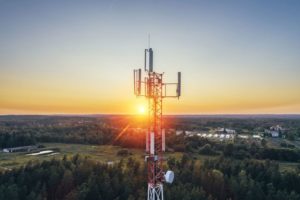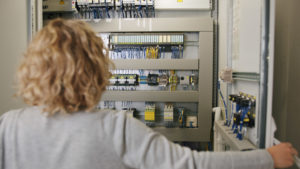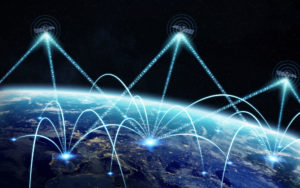4G – what’s that?
4G is the colloquial name for the fourth generation mobile radio standard. These standards began with the first generation. This analogue-based technology, known to some as the B or C network, is no longer in use today. Since then, the mobile radio standard has continued to develop. Currently, generations two to five are in use, with the fifth generation still under construction – but more on that later.

4G, NB-IoT, LTE, NB1 – We shed ligth on the confusion of abbreviations
With the introduction of Release 8 of the 3GPP (3rd Generation Partnership Project), the standardisation body for mobile radio standards, LTE(Long Term Evolution) came into being in2008. As described in the release, LTE belongs to the fourth generation of mobile communications. The launch was also seen asthe birth of 4G. Today, the two terms LTE and 4G are often used synonymously.
If you look at the development of mobile radio standards over the years, you can see that data rates have steadily increased. This trend is due to the strongspread of the mobile internet(mobile broadband). For a long time, the driving forces were the increasing data rates and subscriber numbers. Along with this, the end devices became more and more expensive and energy-hungry, which, however, was practically not noticeable for the end users due to the constant improvement of the battery technology.
In contrast, the remote transmission of measured values places different demands on mobile radio. High reliability,lowenergy requirements, cost-effective hardware, worldwide applicability andlow latency in some cases are the parameters that define the cornerstones for machine-to-machine and Internet of Things communication. Release 13 in 2015 provided 3GPP’s response to these requirements. In addition, the release also coined the names as they are still used today – NB-IoT,M1and NB1.
Within 4G, two mobile technologies exist. The difference to classic LTE (mobile broadband) is that these two technologies have been trimmed for IoT applications. Synonyms exist for both technologies:
- NB-IoT / NB1 (in Release 14 NB2 followed as an extension for NB1)
- M1 / LTE-M1 / eMTC
It was a long way…
Prior to Release 13, the term LTE-CAT1 has become increasingly prominent in the IoT sector. LTE-CAT1 is something completely different from LTE-M1. In fact, LTE-CAT1 is the LTE at its birth – i.e. in 2008. However, it was not used as the first 4G technology at that time because it had a significantly lower data rate (10Mbit downlink) than the established and widespread 3G technologies (>>50Mbit DL). LTE end devices such as smartphones, which have appeared on the market in large quantities since then, are mostly CAT3 or better (> 100Mbit DL).
The time before Release 13 was extremely gloomy for IoT users – comparable to an IoT mobile radio middle age. There was a veritable chaos of terms for years. Many ideas were voiced, which disappeared again a short time later. What remained were many different terms, which only made the chaos worse.
Moreover, 2G was the most widely used technology for IoT at that time. 3G was already many times more expensive and the widely used 4G (CAT3+) was not affordable. . In addition, some countries – first and foremost Switzerland – announced the end of 2G. This created the compulsion to use 3G/4G in addition to 2G or at least to find a migration path. Companies with the target market “DACH region” were automatically forced to act.
This development helped LTE CAT1 solutions to gain more attention. . The available CAT1 modems were many timescheaper than CAT3+ modems and, with the technological advantages of LTE over UMTS, were considered future-proof. Only with Release 13 did a ray of hope emerge for IoT providers. Nevertheless, the available modems that supported NB-IoT or LTE-M1 were still far from fault-free at that time. Only now – at the end of 2021 – can we talk about having survived the worst and being able to implement such solutions with fewer frictional losses.
It´s a match – the right connectivity for my application
We have already clarified what is hidden behind the many abbreviations and which terms can be used synonymously. The next step provides information on which connectivity is used when.
- NB-IoT is designed for extremely small amounts of data and should be used message-based. An IoT application that used to be solved by sending SMS messages is now implemented with the help of NB1.
- LTE-M1 is a further development of 2G – the modern answer to 2G-EDGE, so to speak. It is therefore well suited for all IoT solutions that require a TCP/IP connection, but not high data rates. However, despite the TCP/IP capability of LTE-M1, it would not please the end user on the smartphone, as the data rates of LTE-M1 are still like in the year 2000.
- LTE-CAT1 is suitable for solutions that require a slightly higher data rate, such as the transmission of individual images or a recordset (set of audio recordings).
- 3G technologies have been used in the meantime, but have lost their importance in the IoT world. Current trends point in the direction of LTE-M1/LTE-CAT1 or NB-IoT. The current trends point in the direction of LTE-M1/LTE-CAT1 or NB-IoT.
Why two antennas are not always better than one
In some cases, two antennas are needed for 4G transmission. In order to clarify when and why this is the case, we need to go a little further. With 3G/UMTS, the term “RX diversity” was first coined. This means that an “RX-only” – i.e. an additional receiving antenna – is attached to the terminal in addition to the main antenna. The antennas should be in different polarisation planes. This improves thesignal quality at the moving terminal –> >two antennas receive more than one!
In the course of LTE, the idea was further developed. The result was “MIMO” (Multiple Input – Multiple Output), which was implemented in CAT3 as a 2×2 configuration. This means that in LTE-CAT3 by definition two antennas, which are both transmitting and receiving antennas, are integrated both in the terminal and in the base station. For CAT3+ approval, this requirement is assumed. In LTE-CAT1, in contrast, there is still no MIMO and therefore no need for a second antenna. What does exist, however, is the RX diversity already mentioned.

The myDatalogEASY IoT 2G/4G, for example, has an LTE-CAT1 modem with 2G fallback, i.e. a main antenna and a diversity receiving antenna. With the diversity antenna, the signal quality can also be improved in LTE-CAT1, even if it is not actually necessary there, since the range of 4G is higher than the range of 3G anyway.
With the myDatalogEASY IOT 2G/M1/NB1 World, I only need one antenna in comparison. This is the case because there is no RX diversity in LTE-M1 and NB-IoT in the 3GPP specifications. For this reason, corresponding modems have only one antenna connection instead of two. Adding the RX diversity externally would be possible, but would not make sense. The range of LTE-M1 and NB-IoT devices is higher anyway due to the higher link budget. The additional costs that would be incurred for the second antenna are therefore not justifiable.
In summary – that’s how many antennas I need:
The requirement is often specified by the manufacturer. Nevertheless, the following can be summarised:
- 2G: one antenna
- 3G with RX-diversity: two antennas mandatory
- 4G LTE-CAT1: second antenna optional
- 4G LTE-CAT3+: two (or more) antennas mandatory
- 4G LTE-M1: one antenna
- 4G NB-IoT: one antenna
The hype around 5G – justified or not?
As already mentioned, 4G can finally be used without any problems. To dream of 5G now is therefore a bit far-fetched. With New-Radio (NR), 5G does receive significant improvements to the RAN – especially in the segment of real-time capability (uRLLC), which is currently not possible in 4G – but the network must also be converted to NR for this. Due to the high penetration of LTE base stations, however, this conversion will probably take time. There is a possibility that 4G and 5G will be used together in the future. One speaks of an infrastructure of 4G and 5G base stations coexisting together in a 5G core network. From the current perspective, 5G is therefore more in competition with WiFi, in the area of eMBB (enhanced Mobile Broadband) in the so-called “campus networks”.
Conclusion:
4G already provides a solution for most current IoT solutions. Those who need a solution now are well advised to use 4G. But those who have enough time, money and patience at their disposal are also welcome to try their hand at 5G.


